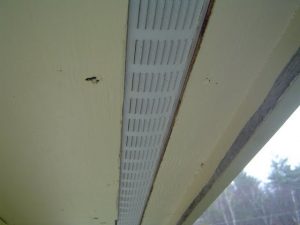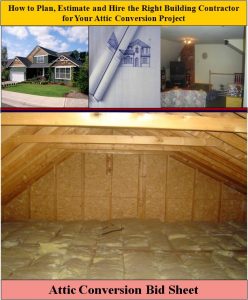The Inclusion of Cold-Side Venting is Essential for Eliminating Attic Vapor Pressure
By Mark J. Donovan
|
|
Attic ventilation control is critical for preventing mold and mildew growth in the attic. It is important to make sure air can flow freely in the attic.
If there is inadequate attic ventilation control, moisture that moves through the ceiling will become trapped in the attic. Fortunately and unfortunately roofing materials do not allow the transfer of moisture between the attic and the outside. |
Consequently, when framing and shingling a roof, it is essential to incorporate adequate attic ventilation control in the design of the home.
One method of attic ventilation control is to include cold-side venting into the attic.
Cold side venting effectively involves including soffit vents and ridge vents, and/or gable vents in the attic so that any build up of vapor pressure, or moisture is transferred from the attic to the outside.
| Installing soffit vents distributed evenly along the roof eaves and a ridge vent along the peak of the roof is the best way for controlling ventilation moisture.
As the attic air warms it lifts upwards and escapes out the ridge vent, and in the process, pulls in cooler drier air from the soffit vents. The beauty of this type of attic ventilation control system is that no wind or powered fans are required. |
 |
For sufficient attic ventilation control one square foot of ventilation should be provided for every 150 square feet of attic area. In addition to soffit and ridge vents you can also use gable, roof and turbine vents. Gable vents are placed near the top of the gable ends of the roof. Roof vents are installed on the roof. Typically when using roof vents for attic ventilation control, many of them need to be installed on a roof.
It is essential that when installing attic insulation that the rafter channels are not obstructed with insulation so that air cannot flow properly from the soffit vents in the attic eaves up into the attic. If insulation is jammed into the attic soffit areas, fresh cool air will not be able to be drawn into the attic.
For help on Attic Conversion and Attic Renovation Projects, see HomeAdditionPlus.com’s Attic Conversion Bid Sheet. The Attic Conversion Bid sheet will help to ensure that you hire the right contractor so that your attic conversion project is built correctly, on time and budget.
Related Information
- How to Ensure Proper Attic Ventilation
- How to Prevent Ice Damming
- How to Prevent Frost Forming in Your Attic
Additional Attic Conversion and Home Remodeling Design Resources
 |
 |
Free Home Addition / Attic Conversion Price Quotes with No Obligation!
Fill out our 3-5 minute quick and easy form, and receive a free price quote on a attic conversion from one of our pre-screened and licensed home remodeling contractors. This process is free and there is no obligation to continue once you receive your attic conversion price estimate.

